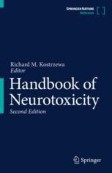Search
Search Results
-
Co-immunoprecipitation as a Useful Tool for Detection of G Protein-Coupled Receptor Oligomers
Allosteric interactions between transmembrane G protein-coupled receptors (GPCRs) could lead to conformational changes and therefore oligomer...
-
Neurotoxicity in Psychostimulant and Opiate Addiction
Psychostimulants and opioids evoke toxicity within the central nervous system (CNS), primarily linked to action of the substance (e.g., enhancement...
-
Neurotoxicity in Psychostimulant and Opiate Addiction
Psychostimulants and opioids evoke toxicity within the central nervous system (CNS), primarily linked to action of the substance (e.g., enhancement...
-
Pharmacology of Histamine, Its Receptors and Antagonists in the Modulation of Physiological Functions
Histamine is an important monoamine consisting of an imidazole ring, which is connected to the amino group by an ethylene group. It is biosynthesized...
-
Dissecting the Relationship Between Neuropsychiatric and Neurodegenerative Disorders
AbstractNeurodegenerative diseases (NDDs) and neuropsychiatric disorders (NPDs) are two common causes of death in elderly people, which includes...

-
Alterations in Gene and Protein Expression of Cannabinoid CB2 and GPR55 Receptors in the Dorsolateral Prefrontal Cortex of Suicide Victims
Recent studies point to the cannabinoid CB 2 receptors (CB 2 r) and the non-cannabinoid receptor GPR55 as potential key targets involved in the response...

-
Heteroreceptor Complexes Formed by Dopamine D1, Histamine H3, and N-Methyl-D-Aspartate Glutamate Receptors as Targets to Prevent Neuronal Death in Alzheimer’s Disease
Alzheimer’s disease (AD) is a neurodegenerative disorder causing progressive memory loss and cognitive dysfunction. Anti-AD strategies targeting cell...

-
Effects of intra-accumbal or intra-prefrontal cortex microinjections of adenosine 2A receptor ligands on responses to cocaine reward and seeking in rats
Rationale and objectivesMany studies indicated that adenosine via its A 2A receptors influences the behavioral effects of cocaine by modulating...

-
PKC Mediates LPS-Induced IL-1β Expression and Participates in the Pro-inflammatory Effect of A2AR Under High Glutamate Concentrations in Mouse Microglia
Pathogens such as bacterial lipopolysaccharide (LPS) play an important role in promoting the production of the inflammatory cytokines interleukin-1...

-
Pharmacological Targets and Mechanisms of Action of Antipsychotic Substances in the Context of the Neurochemical Theory of the Pathogenesis of Schizophrenia
Schizophrenia is characterized by neurochemical, morphological, bioelectrical, and behavioral changes in the body, which overall produce a system of...
-
Receptor Tyrosine Kinases: Principles and Functions in Glioma Invasion
Protein tyrosine kinases are enzymes that are capable of adding a phosphate group to specific tyrosines on target proteins. A receptor tyrosine...
-

-
Amyloid precursor protein regulates 5-fluorouracil resistance in human hepatocellular carcinoma cells by inhibiting the mitochondrial apoptotic pathway
Hepatocellular carcinoma (HCC) is a malignant tumor with high morbidity and mortality globally. It accounts for the majority of primary liver cancer...
-
Use of Superfused Synaptosomes to Understand the Role of Receptor–Receptor Interactions as Integrative Mechanisms in Nerve Terminals from Selected Brain Region
Synaptosomes are sealed presynaptic nerve terminals obtained by homogenizing selected brain regions under iso-osmotic conditions. This preparation...
-
An infection of Enterobacter ludwigii affects development and causes age-dependent neurodegeneration in Drosophila melanogaster
AbstractThe effects of teeth-blackening bacteria Enterobacter ludwigii on the physiological system were investigated using the model organism Drosophi...

-
In Situ Proximity Ligation Assay to Study and Understand the Distribution and Balance of GPCR Homo- and Heteroreceptor Complexes in the Brain
The existence of homo- and heteroreceptor complexes with allosteric receptor-receptor interactions increases the diversity of receptor function...
-
Cocaine Blocks Effects of Hunger Hormone, Ghrelin, Via Interaction with Neuronal Sigma-1 Receptors
Despite ancient knowledge on cocaine appetite-suppressant action, the molecular basis of such fact remains unknown. Addiction/eating disorders (e.g.,...

-
On the Study of D4R-MOR Receptor–Receptor Interaction in the Rat Caudate Putamen: Relevance on Morphine Addiction
Receptor–receptor interactions that occur in G protein-coupled receptors (GPCRs) oligomers can be explored using three different functional...
-
Orexin A/Hypocretin Modulates Leptin Receptor-Mediated Signaling by Allosteric Modulations Mediated by the Ghrelin GHS-R1A Receptor in Hypothalamic Neurons
The hypothalamus is a key integrator of nutrient-seeking signals in the form of hormones and metabolites originated in both the central nervous...

-
Behavioral Methods to Study the Impact of Receptor–Receptor Interactions in Fear and Anxiety
An important step forward in understanding synaptic transmission has been the discovery that within the realm of G-protein coupled receptors (GPCRs)...
